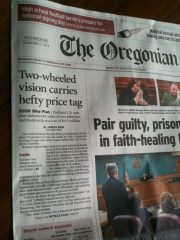
The Oregonian published a front page story today on the 2030 bike plan titled, Two-wheeled vision carries hefty price tag .
In my opinion, the article (which was also sold to the Associated Press and is being picked up nationwide) frames the plan as a massive expenditure that’s being shoved down the throat of Portlanders by Orwellian city officials with the full support of Mayor Adams.
Instead of helping to foster civil public discourse about a very important plan for our city’s future, I’m afraid this story will only serve to intensify the “bicyclist” versus “motorist” sensationalism that The Oregonian has admitted to “overplaying” in the past.
The article makes apples-to-oranges comparisons of the price of the completed bike plan ($613 million) to the $575 million MAX Green Line (which is funded by the federal government), and “all transportation projects in the metro area” ($630 million a year). Then, despite the fact that the plan does not commit the city to spending anything on bikeways, the article states that Mayor Sam Adams “doesn’t flinch at the estimated cost.”
Then the article, as per usual in the template of us vs. them stories, is this line: “Critics think the mayor and cycling advocates are dreaming…”
To act as the “critic,” the story quotes John Charles from the Cascade Policy Institute, a libertarian think tank well-known for their lack of support for bicycles as transportation. Charles told the paper, “They want to make bicycling more attractive than driving for all trips of three miles or less… Nothing they do is going to make that happen for most people.”
Charles is right about that. 25% of Portlanders is not “most people.” 25% is PBOT’s best guess as to the amount of people who are likely to start riding if there were more comfortable places to do so.
This is an important point: The bike plan is not about creating a city where you must bike. Live 10 miles from town and need to get to work? Go ahead and drive (although transit would be a good option). Need to pick up a couch from Macy’s downtown? Go ahead and drive. There is nothing wrong with using a car when you need to. The problem is that because the way our infrastructure and policies have been historically set up, too many people need to drive too often.
The Oregonian then references George Orwell (which is really a perfect reference if you’re trying to scare people about a big huge plan that will dictate how they live well into the future):
“…one might think of George Orwell after visiting the city’s official bike plan web site, which encourages visitors to “click here to express your support.”
Oppose the plan? Have legitimate concerns about it? Sorry. No link for you.”
The Oregonian would lead its readers to believe that because PBOT is guilty of being enthusiastic about the plan, they are somehow involved in a conspiracy to keep opposition quiet (the article did not mention the large-scale, two-year public outreach process that took the plan to nearly every neighborhood in the city).
Back to Mr. Charles from the Cascade Policy Institute:
“Still, given the city’s shaky transportation budget and the fact that the so-called “Copenhagen on the Willamette” already is considered a world-class bicycling city, some wonder if the plan is even needed.
Charles wonders why, when technology and culture are changing at a rapid pace, Portland is planning 20 years into the future. He compared it to a business in 1980 committing to 20 years of IBM typewriter purchases, unaware that the computer revolution was on the horizon.”
Don’t need a plan? Excuse me Mr. Charles and Mr. Rose, but plans are simply how cities work. Portland has a Freight Action Plan, a Climate Action Plan, a Parks Action Plan, and so on. The thinking is, if you want to make educated decisions about the future, it helps to have a framework (a.k.a. plan) to guide you — and 20 years is standard length for these sorts of planning documents.
Like I repeated to an AM radio talk show host this morning who referred to the $613 million for the completed plan as “A big wad of money!,” the 2030 bike plan does not commit the city to any expenditures. As Mr. Rose points out in his story, it does mandate getting some people together to figure out how to pay for the bikeways (which seems like a reasonable thing to do). The plan also lays out detailed implementation strategies if and when funds become available.
The 1996 plan had a similarly expansive vision and called for 630 miles of bikeways. Despite that plan being adopted nearly 15 years ago, we’ve only got about 300 miles built (and they’ve spent only $60 million, about the cost of one mile of urban freeway). See? No hysteria needed.
Will the city spend money on bikeways in the future? Yes. Will they spend more money than they have in the past? Yes! Why? Because our city leaders — and I would bet a majority of Portland residents — understand that our current transportation system is not functioning as well as it should and encouraging more trips by bicycle is one way to fix it.
I welcome a public conversation about bike spending and about how we’re going to fix our transportation problems (crumbling roads, injury and death, emissions, congestion, etc…), but this “news” story from the paper of record in our great state feels like it was more about stirring up the old bicyclist versus motorist dichotomy than presenting the issue in an accurate way.
Whether you’re for or against the bike plan, I hope you all show up at City Hall tomorrow at 2:00pm.

